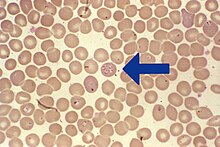Babesia
| Babesia | |
|---|---|
 |
|
| Scientific classification | |
| Domain: | Eukaryota |
| (unranked): | SAR |
| (unranked): | Alveolata |
| Phylum: | Apicomplexa |
| Class: | Aconoidasida |
| Order: | Piroplasmida |
| Family: | Babesiidae |
| Genus: | Babesia |
| Species | |
|
Babesia bigemina |
|
Babesia bigemina
Babesia bovis
Babesia caballi
Babesia canis
Babesia cati
Babesia crassa
Babesia divergens
Babesia duncani
Babesia felis
Babesia gibsoni
Babesia herpailuri
Babesia jakimovi
Babesia major
Babesia microti
Babesia motasi
Babesia ovate
Babesia ovis
Babesia pantherae
Babesia sp. 'North Carolina dog'
Babesia (also called Nuttallia) is an Apicomplexan parasite that infects red blood cells causing a disease known as babesiosis. Originally discovered by the Romanian bacteriologist Victor Babeș, over 100 species of Babesia have been identified, but only a few have been documented to cause disease in humans.
In the United States, B. microti is the most common strain associated with humans. Other species infect cattle, livestock, and occasionally domestic animals. People who contract babesiosis suffer from malaria-like symptoms. As a result, malaria is a common misdiagnosis for the disease.
Babesia is a protozoan parasite of which B. microti and B. divergens are the two species most frequently found to infect humans. Infections from other species of Babesia have been documented in humans, but are not regularly seen. Babesiosis is also known as piroplasmosis. Due to historical misclassifications, this protozoan was labeled with many names that are no longer used. Common names of the disease include Texas cattle fever, redwater fever, tick fever, and Nantucket fever.
Although it was initially reported that the mitochondrial genome is circular unlike other sequenced Apicomplexa mitochondrial genomes, this has now been revised. The mitochondrial genome is actually linear.
...
Wikipedia
